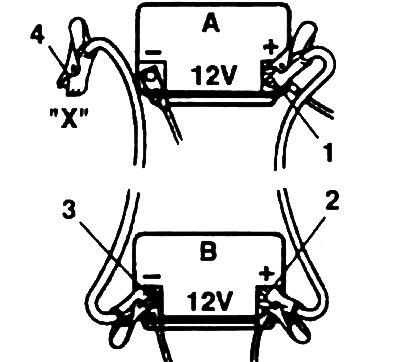Attention! If the prescribed connection recommendations are not strictly observed, there is a risk of burns due to spilled electrolyte, which is based on sulfuric acid. In addition, injuries or bruises may result from the battery exploding, or electrical equipment may malfunction.
The cross section of the wire for connecting the starter to the auxiliary battery must be at least 16 mm2 (diameter approx. 5 mm) for internal combustion engines with forced spark ignition of the working mixture up to a cylinder volume of 2.5 liters. For engines with a cylinder capacity of more than 2.5 liters and for diesel engines, the cross section of this wire must be at least 25 mm2. In this case, the determining factor is, of course, a car with a discharged battery. As a rule, the cross section of the wire is indicated on its packaging. It is recommended to purchase this wire with insulated collets and a cross section of 25 mm2, as it is also suitable for engines with a relatively lower displacement.
Both batteries must have a voltage of 12 volts.
A discharged battery can freeze even at -10°C. Before connecting the wire to connect the starter to the auxiliary (outside the car) battery, a frozen battery must be defrosted.
A discharged battery must be properly connected to the on-board electrical network.
Check the fluid level in the discharged battery. Top up with distilled water if necessary.
Install the cars at such a distance from each other that there is no metal contact between them. Otherwise, a current may already flow when the positive pole is connected.
For both vehicles, tighten the handbrake lever. Set the manual transmission to neutral or, in the case of an automatic transmission, to park "R".
Disconnect all current consumers.
The auxiliary vehicle engine must be running during the starting process of the main vehicle at idle speed. This eliminates the possibility of damage to the generator due to voltage peaks that occur during start-up.
During starting, avoid open flames and burning cigarettes near the battery, as combustible gases may be emitted from it.
Take care that the wires connecting the starter to the auxiliary battery cannot be damaged by rotating parts such as the engine cooling fan.

Connect the starter wires to the auxiliary battery as follows:
1. Connect the red wire to the positive terminal of the discharged battery -A-.
2. Connect the other end of the red wire to the positive pole terminal of the battery supplying current -B-.
3. Connect the black wire to the negative terminal of the supply battery.
4. Connect the other end of the black wire to a good point on the chassis -X- of the receiving vehicle. A metal part screwed to the engine block is best suited for this. Under unfavorable circumstances: when connecting a wire to the negative pole of a discharged battery, the latter may explode due to sparking and release of explosive gas.
Attention! The wire terminals for connecting the starter to the auxiliary battery of the connected wires must not contact each other, or the positive terminals must not come into contact with the case (body or frame).
Start and run the engine of the receiving vehicle (discharged battery). When starting, continuously press the starter for no more than 10 seconds, as the high current consumption heats up the pole clamps and wires. So sometimes endure "cooling pause" at least 1/2 minute.
Do not lean over the batteries - there is a risk of injury!
After starting the engine, disconnect the clamps from the terminals in reverse order: first, disconnect the black wire from the terminal (-) on the receiving vehicle, and then on the supply vehicle. first disconnect the red wire from the terminal on the supply vehicle, and then on the receiving vehicle.
Visitor comments